I had neglected to properly promote four recent "Toronto Events" articles featured in my DeHaan Services site.
Cycling for the Rouge Valley
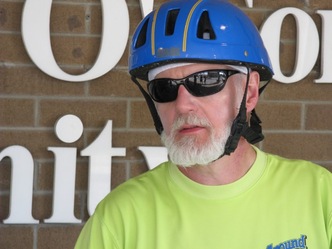 "Mike DeHaan as a Cyclist" image by Roger Horst
June Toronto Bike Month in Toronto
Actually, " Toronto Bike Month 2012 for Fitness and Events" reports accurately that Bike Month actually starts near the end of May. I was annoyed that I missed out on the opening day's pancake breakfast at City Hall. Read the article to for more opportunities to join cycling tours and other events.Toronto Bike Month inspired me to write a more general article, " Great Reasons to Bicycle in Spring 2012", in my DeHaan Fitness and Weight Control blog. Scheduling the Centre Island Ferry in Toronto
The Toronto Islands offer terrific outdoor activities, including cycling, bicycle rentals, and the famous Centre Island amusement park. Could City Hall possibly improve their schedule for ferry service? "Can the Toronto Centre Island Ferry Schedule be Improved?" says "Yes, and here's how". DesiFEST at Yonge-Dundas Square
Yet another Toronto ethnic and cultural festival is highlighted in " Visit DesiFEST 2012 for a Free 12 Hour Concert". If you're reading this, you missed it for 2012. Check the article for another East Indian festival coming later this summer at the same location. Also, save the same weekend in 2013 for another opportunity to enjoy South Asian culture.One Writing Tip from Four Articles
This writing tip is obvious.
Once you have set up a process for publicizing your work, ensure that you stick to it.
Let your friends and followers know. Let the search engines crawl your "do follow" promotional pages.
If it was worth writing and publishing in the first place, it's worth promoting afterwards.
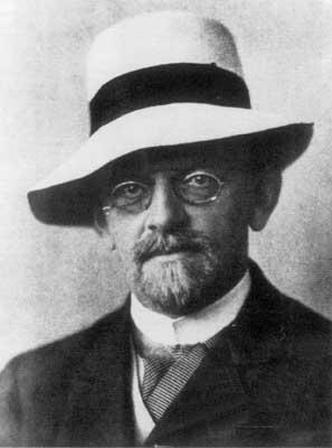 "David Hilbert" in a University of Göttingen faculty image in 1912. Hilbert's "Decision Problem" asks whether a mathematical system can contain a process to decide whether a statement in that system can be proven.
Alan Turing proved that his "Turing machine" resolved Hilbert's question.
My article explains that resolution: can such a process exist, or is it impossible?
Promoting the Decision Problem
Today's Writing Tip
Today's writing tip has been mentioned before, but it is especially relevant to the end of my series about Turing machines. Whether you write for a magazine or simply in your own blog, sometimes it's worthwhile to plan ahead and build a series of articles. As a case in point, Alan Turing received a lot of publicity this year. I knew that there is a lot to say about the math involved in the Turing machine. Rather than try to cover too much material in one article, I deliberately started with an introduction, moved on to more elaborate capabilities of Turing machines, and ended with one article about the Halting Problem and finally the Decision Problem.Consider this when you tackle a new topic. Almost any article needs an introduction, body and conclusion. Ask yourself a few questions: - Is there enough material to break into separate articles?
- Can each article stand on its own, even if it needs a brief recap in the introduction?
- What is the logical flow for these articles?
Typically, a series can flow chronologically, from the past to the present and future; from simple to complex; or from familiar to bizarre. One of the great strengths of online writing is that you can hyperlink pages, so your readers can either retrace their steps or move forward smoothly. Finally, always remember that some readers will pop into the middle of your series. Be sure to give them a link to the first article. This usually fits nicely into the introduction for each. You're invited to see how I did it in the Turing machine series. It started with "A Brief Introduction to the Turing Machine".
This article is neither magic nor geometry; it simply promotes five recent articles.
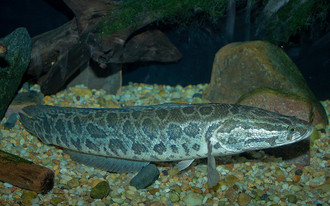 "Northern Snakehead Fish, or Channa argus" by brian.gratwicke " Has the Northern Snakehead Fish Invaded British Columbia?" is still an unanswered question in Burnaby, BC. Naturalists are searching the lagoon to confirm or deny the presence of this invasive species. Nonetheless, my Environmental Graffiti article includes background and images gleaned from other sources.
Two Articles in Double Fitness
I wrote " One Timely Weight Loss Tip" to summarize new research indicating that disciplined timing of meals can help one lose weight. David Haas submitted a guest article, " Healthy Habits for Coping with Cancer", explaining why cancer patients should start or maintain a minimal exercise program. My DeHaan Fitness and Weight Loss site had been in need of new articles, but not neglected since I continue to document Mayor Rob Ford's progress in his "Cut the Waist" challenge. Double Posts in DeHaan Services
One 5-Pack Promotion in Xanga
I wrote one promotional entry in my Xanga blog for precisely the same reason that this Weebly article holds a fist full of publicity: I was too busy to write individual blog posts. " 5 DeHaan Articles in May 2012" covers precisely the same ground as this article. A Single Writing Tip
Today's writing tip only relates to one of my articles: " Visit DesiFEST 2012 for a Free 12 Hour Concert". The tip is to plan your content before simply writing an article or making a blog entry. This applies even to simple, personal articles; but it is more important if you do research and expect to have your facts straight.I had to make three trivial updates to that article.- Although I had checked the TTC home page for warnings of service interruptions, I had to go back and update the article because the Yonge subway really is closed downtown this weekend. (Only the Yonge line from Bloor to Union; you can take the University line instead).
- I forgot that Rogers supplies internet, as well as cable TV and cell telephone service.
- Most foolishly, I forgot the disclaimer that I don't have a financial interest in the event.
I do blame the way the TTC home page avoided mentioning the planned work; it was noted on the page for the Dundas 505 streetcar instead. The other two were avoidable mistakes, and I should have been more thoughtful from the start. Learn from my mistakes, and apply this writing tip to your own articles!Thanks for reading my publicity for: snakehead fish in Burnaby, BC; timing meals as a weight loss tip; maintaining fitness despite having cancer; improving the Toronto Island ferry schedule; and noting a free South Asian festival in Toronto.
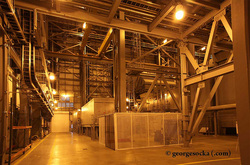 "Inside the Portlands Energy Centre" image by George Socka of beachdigital.com After writing and publishing this article, I was concerned that people might think the topic is a "WordPress theme" rather than an organizing principle for deciding which buildings to visit.
By the way, "Doors Open Toronto" is an annual event, but there so many buildings are included that it would be difficult to run out of options.
Promoting my Toronto Doors Open Article
Writing Tip
Originally I planned to go to the nearest easily accessible building to take a photograph for this article.
On a whim, I searched Flickr for the keywords and for a "commercial reuse" license. Behold the image already available thanks to George Socka of beachdigital.com!
Today's writing tip is to check for existing images before spending the time to make your own. Mr. Socka did a much better job than I could, and saved me time.
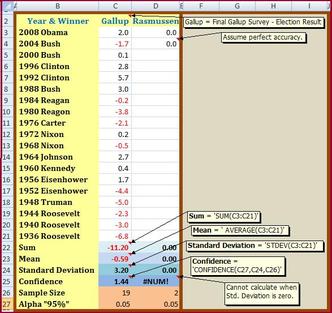 "Poll Accuracy" image by Mike DeHaan By publishing the image here, before it appears in the main article, I establish copyright and ownership.
Further Publicity
Writing Tip on Creating Images
Today we present two writing tips about making your own images for online articles. First, consider making a simple spreadsheet to illustrate your point. It's smart to keep it fairly small, so it fits and can be as visible as possible. Add a border so it does not fade into the background of the web page. Second, publish your image in a site that you control, to establish your copyright, before publishing it in someone else's online magazine.You could place it on Flickr, for example, and set precisely the restrictions that you want. Or you could make it open for anyone to re-use or adapt. At the least, you should license it "with attribution" so your name will spread.By the way: read the Terms of Service ('TOS') before you start storing images online. Some people have complained that various sites say that you give up all control over images displayed on their pages. It's not a case of "don't trust that magazine publisher"; rather it is a matter of establishing control so you can use the image yourself in the future.
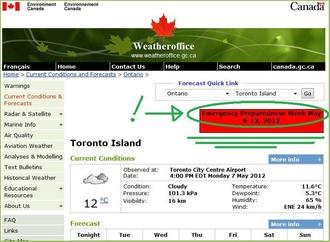 "Environment Canada with Red Banner Link" image by Mike DeHaan I made the above image to show where I had found the link to the Canadian government's emergency preparedness site.
One of the points in my article is that the traditional media did not make me aware of this event. Nor did Vic Toews get his share of the spotlight. ("Vic Who"? Sorry, please just read my article to see why he's associated with getting Canadians ready for emergencies).
Shameless Publicity for Emergency Preparedness
Writing Tip: Why I Wrote about Emergency Preparedness
My blog post in DeHaan Services is an example of creating an article without developing the expertise in the topic. In this situation, I am not an expert in preparing for emergency situations.
Instead, my public service goal was to point at the Canadian government's web site that does indeed have expert advice.
The "hook" for the article was that, as far as I knew, the traditional media had missed the story.
So today's writing tip is: find a worthwhile topic that others have missed; highlight your find; and point to the resource where the expertise can be found.
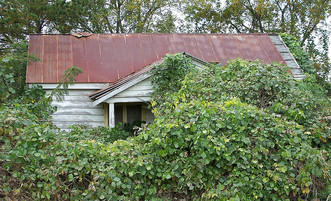 "Kudzu Engulfing a House", image by NatalieMaynor This American home is falling victim to a merciless invader. Could Canada be next? Can, should and will the Americans allow another invasive species to retaliate? Learn the basic issues from my kudzu article.
Promoting my Kudzu Article
Writing Tip, based on Kudzu
Today's writing tip suggests that you remain open to surprises as you research a topic.
First, "surprising equals informative" in the math of information theory. If you were surprised, it's likely your reader will find the article informative.
Second, your surprise can open your relationship with your readers. I had not known that anyone in the USA would think of kudzu as beneficial for anything. My article explains why some do; and that can be the start of soliciting reader engagement.
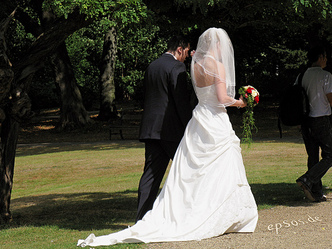 "Bride and Groom" image by epSos.de The challenge was to attract a large number of comments, presumably without saying "Please, please, please make comments" in the actual article.
Perhaps the topic of "arranged marriage" is controversial enough for comments. I couldn't think of anything very controversial in my niches of mathematics and computing theory.
Publicity for Arranged Marriages
Writing Tip
I had actually noticed an article about this kind of computer program, but had not really considered writing about it from this angle until the contest was announced.
Today's writing tip is that one must notice much, but select and write pointedly for a topic.
This article uses "arranged marriage" to introduce and develop the broader mathematical topic of Hall's Theorem. Will people read it simply because they have preconceived notions about families planning their children's betrothals? Perhaps; but then they might also learn about math!
|









 RSS Feed
RSS Feed